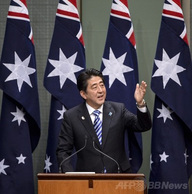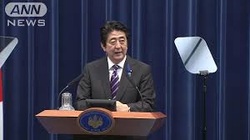 Source: irorio.com
Source: irorio.com Any attempt to grasp the nature of Japanese foreign policy as it has been practised during the modern era must begin with an examination of the system created in the wake of Japan’s defeat in WWII and how this became the foundation for all diplomatic thinking that subsequently followed it. This system, the so-called “Yoshida Doctrine”, was named after post-war Prime Minister Shigeru Yoshida (who served in office from 1948 to 1954), a former diplomat and one of the founders of what would become the Liberal Democratic Party of Japan[1].
The essential ideology behind the Yoshida Doctrine was based on necessity given the concern at the time surrounding the international and domestic influence of communism. The doctrine emphasised that Japan would maintain a close alliance with the United States, that it would only commit itself to a minimal level of rearmament, and that economy recovery would be prioritised above all other concerns.
It was, in many ways, the only form of foreign policy doctrine that would satisfy the many competing elements within Japanese politics, for while businesses and economic ministries wanted Japan to focus purely on economic development, anti-communists and pacifists argued among one another on whether Japan should rearm to defend itself against the threats posed by the Cold War, or whether Japan should strictly follow the terms laid out in the newly adopted Constitution and forsake all military capability[2].
That the Constitution should prove so divisive was certainly far from what its creators had first intended. With Japan’s sovereignty suspended in the aftermath of WWII, the Allied powers, led principally by the United States, had deemed it necessary for Japan to have a constitution that would permanently shift the right of sovereignty from the Imperial household to the people, and prevent a re-surge in militarism through the renunciation of war and the guarantee of democracy.
This was a reflection of the conditions laid out in the Potsdam Declaration of July 1945. Though the drafting of the constitution was difficult, and at one stage had to be completely re-written following objections from General Douglas McArthur that it still favoured former Imperial institutions, the document was adopted by the Japanese Diet and came into effect on May 3, 1947[3].
The three main features of the Constitution were that it reduced the Emperor to a symbol, it promoted the idea of human rights and democratic rule, and it renounced the capacity of Japan to ever again wage war, which included the right to belligerency and to possess armed forces. This last feature was embedded in the language of Article 9, probably the most well-known of all of the articles in the Constitution. Yet obviously this left a dilemma, for unarmed neutrality can only be guaranteed if all surrounding nations agree to accept the status-quo[4].
Hence Japan had two choices to make – it could either rely solely on protection from the UN, or it could rely on another foreign power for its security[5]. Since Prime Minister Yoshida was averse to wanting to join the Communist bloc, believing as he did that Japan’s national security and economic recovery could only be guaranteed through its association with the free market and liberal democratic values, he reasoned that Japan would be of strategic value to the US, not only geographically but also in terms of Japan’s ability to manufacture goods for the US.
In the end, the choice was obvious. The San Francisco Treaty of 1951 re-established Japanese sovereignty, while in the same year Japan agreed to the first US-Japanese security treaty giving the US the right to continue to maintain bases in Japan. While pacifist groups objected to the latter treaty, concerned that it could drag Japan into a US-led conflict, Yoshida realised that this was the only way Japan could maintain its security without pledging to increase its military strength[6].
For the next few years Japan focused its energies on rebuilding its economy, primarily through exports to the US and Western countries, and placed any major debate related to foreign policy aside.
Yet soon both Japanese politicians and intellectuals were questioning the dependent relationship that Japan shared with the United States, and that Japan should pursue its own national strategy and identity[7]. In the wake of Prime Minister Yoshida came Hatoyama Ichirō, who in 1956 attempted to create something of an independent foreign policy initiative by moving to normalise relations with the Soviet Union while also re-writing the Constitution. Although Hatoyama’s initiatives were defeated, it spurred the Ministry of Foreign Affairs to release the first Diplomatic Blue Book in 1957 which outlined the three pillars of Japan’s diplomatic strategy – its alliance with the US, diplomacy exercised through the UN, and a focus on Asia[8].
Based on these three principles, the period of the 1960s through to the 1980s saw a number of attempts by various prime ministers to define Japan’s regional role and to build an international identity for Japan. In 1960 Kishi Nobusuke managed to have the US-Japan security treaty revised despite widespread domestic opposition to Japan so closely aligning itself with the US (and risking engagement in foreign conflicts).
This backlash prompted Kishi’s successor Ikeda Hayato to again promise that Japan would concentrate purely on economic growth, so much so that by the end of the 1960s Japan’s technological and economic power was approaching that of the US. This new-found economic power began to convince those within Japan’s industrial community that Japan should pursue a more independent defence and foreign policy, however concerns about how this would be perceived in Washington meant that such ideas did not go beyond the hypothetical stage[9].
Following the visit by US President Richard Nixon to China in February of 1972, members of the LDP, led by Prime Minister Tanaka Kakuei, soon realised that Japan was no longer bound to adhere to US anti-communist doctrine and so signed the Sino-Japanese Joint Statement with China in September of 1972 that normalised relations between the two countries while adding to Japan’s growing interest in pursuing more active ties with other nations in the Asian region[10].
The agreement with China signified a move by Japan’s political leaders that they were prepared to pursue a more independent foreign policy distinct to that of the US, particularly as the war in Vietnam had shaken Japanese faith in the ability of the US to not only provide for Japan’s defence but also to ensure its access to resources[11].
The embargo on oil exports by the Organisation of Petroleum Exporting Countries (or OPEC) in the mid-1970s merely heightened such concerns, for until this period Japan had predominantly depended on Western nations to meet Japan’s energy demands[12]. The impetus was now for Japan to pursue a more multilateral economic policy that moved beyond dependence on the US and Europe, which in turn spurred a greater level of investment in developing countries, particularly countries in Asia, in order to ensure that they could meet Japan’s demand for resources.
This desire for access to growing markets in turn led Prime Minister Tanaka in 1977 to declare that Japan would pursue a closer relationship with Southeast Asia through the institution of ASEAN, a relationship that Professor Gerald Curtis described as…”…one of the outstanding achievements of post war Japanese diplomacy[13].” Hence as Japan’s financial strength grew, so did its desire to establish favourable trading relations with a number of countries which it then reciprocated with aid and other financial donations and investments[14].
By the 1980s, Japan’s confidence in its economic status and ability to influence global markets (starkly demonstrated by Japan’s inclusion in the G-6 nations in the mid-1970s) had given it a newfound desire to raise its profile on the international stage and seek a much more diverse role for itself in global politics[15]. Under Prime Minister Nakasone Yasuhiro, Japan firmly committed itself to Western notions of security and increased its aid donations to third world countries in order to counter the threat posed by the Soviet Union[16].
Nakasone increased defence spending in Japan by 6% per year (from its previous limit of 1% of GDP), and his decision to agree to the G-7’s “Plaza Accord” in 1985, thereby increasing the value of yen, gave Japan a leading role in providing funds for global growth. Under Prime Minister Takeshita Noboru, Japan became the world’s largest donor of ODA (60% of which was going to Asia in 1992[17]) while simultaneously becoming the world’s largest creditor nation[18].
At this point, I will draw this particular chapter to a close, however in subsequent posts I shall try to continue the narrative of Japanese foreign policy as it entered the 1990s and 2000s, much of which had a bearing on the decisions taken recently by the Abe government.
[1] Michael Green, Japan`s Reluctant Realism, Center for Strategic and International Studies, Washington, 2007, p.11
[2] Ibid.
[3] John Dower, Embracing Defeat: Japan in the aftermath of World War II, Penguin Books, London, 1999, pp.360,401
[4] Yutaka Kawashima, Japanese Foreign Policy at the Crossroads: Challenges and Options for the Twenty-First Century, Brookings Institute Press, Washington, 2005, pp.24-25
[5] Ibid.
[6] Ibid, p.26
[7] Michael Green, op.cit, p.13
[8] Ibid, pp.13-14
[9] Ibid, pp.14-15
[10] Ibid.
[11] George R Packard, “The United-States – Japan Security Treaty at 50: Still a grand bargain?”, Foreign Affairs, March/April 2010, website: http://www.foreignaffairs.com/articles/66150/george-r-packard/the-united-states-japan-security-treaty-at-50?page=2, accessed March 12 2012
[12] Yutaka Kawashima, op.cit, p.20
[13] Yoichi Funabashi, “Tokyo’s Depression Diplomacy”, Foreign Affairs, November/December Vol.77 No.6, 1998, p.29
[14] Narongchai Akrasanee and Apichart Prasert, “"The Evolution of ASEAN-Japan Economic Cooperation,", ASEAN-Japan Cooperation:A Foundation for East Asian Community; (ed. Japan Center for International Exchange), Tokyo: Japan Center for International Exchange, 2003, pp. 63-74
[15] Ibid, p.62
[16] Michael Green, op.cit, p.16
[17] Ministry of Foreign Affairs, “50 years of Japan’s ODA” (Pamphlet), Ministry of Foreign Affairs, Tokyo, 2002, website: http://www.mofa.go.jp/policy/oda/cooperation/anniv50/pamphlet/progress3.html, accessed March 23 2012
[18] Ibid.



 RSS Feed
RSS Feed